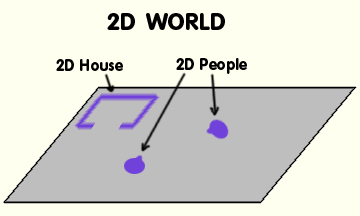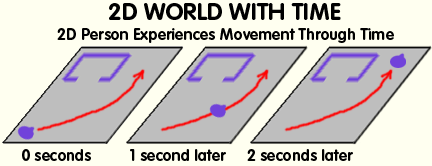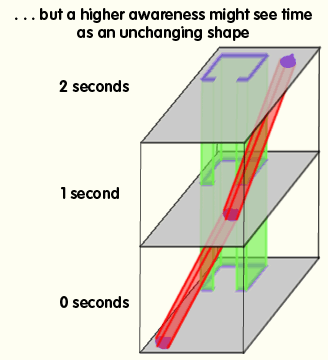
When you are courting a nice girl, an hour seems like a second. When you sit on a red-hot cinder, a second seems like an hour. That's relativity.
-- physicist Albert Einstein
Einstein's idea -- later demonstrated by experiment -- that space and time are relative provoked a revolution in science. No longer were space and time independent of the things in them. In fact, neither are space and time independent of each other -- they form a "continuum," an inseparable mesh.
This "space-time continuum" -- our universe -- has four dimensions (length, width, height and duration). Objects do not move through space and time; they extend, unmoving, through the space-time continuum.
Since it is not easy to visualize four dimensions, scientists have often imagined a fictional two-dimensional world to compare to our own.

Imagine a two-dimensional world -- much like a flat sheet of paper. On this sheet are little two-dimensional people. These 2D people have only two-dimensional senses; they can see their world, but not above or below. Everything in their world has length and width, but no height.

Now imagine that time is our flatlanders' third dimension (what would normally be height). The 2D person experiences himself as moving through time, but someone who could see the third dimension -- time -- would see him as a fixed, unchanging shape, like a series of snapshots connected together.

Our space-time universe may be something like this. From a view outside time, everything that ever happened or will happen may be eternally frozen like a sculpture.
In elementary school we learn basic truths of geometry: parallel lines never cross, and so forth.
One thing that is not mentioned in geometry class is that these truths are not necessarily true in our universe. Two perfectly straight, parallel lines could cross in our universe. Why? Our space-time continuum has a geometry different from the one taught in elementary school.
Imagine a flat wooden board. If you have a ruler, you can start at one spot on the board, and draw straight lines with your ruler, to make a grid pattern. The grid would form perfect squares.
Now imagine that the board isn't flat -- it's been left out in the rain too many times, and is now warped. Now, if you try to make a grid on it with your ruler, you won't be able to make perfect squares, because the wood is warped up and down. Your "straight lines" are straight on the wood, but because the wood itself is curved up and down, your straight lines curve up and down too.
Our universe is like this -- warped and curved. In fact, what we call gravity is a warping of space-time. Objects normally travel in a straight line if left alone, but the planets travel in a curved path around the sun. Why? The sun's mass warps the space-time around it. The planets are travelling in a straight line -- but that straight line is curved in space-time itself.
Gravity warps not only lines in space, but time as well -- the stronger gravity is, the slower time goes! This effect has been measured on earth. A highly accurate clock at the top of a mountain (where gravity is weaker) will run faster than the same type of clock at the bottom of a mountain (where gravity is stronger).
Not only are space and time relative to how fast you are going, but they form an inseparable, warped, four-dimensional mesh that doesn't play by the rules of elementary school geometry.
Time doesn't work according to common sense. There is no such moment "now" valid for the entire universe. Whether things happen "at the same time" is simply a point of view. The entire space-time continuum -- containing all moments of time -- is entirely present.
What does this mean for human concepts like cause and effect, when past and future are one inseparable whole? For free will? Why do we experience ourselves as moving through time if we're not really doing so? It seems that science's answers have only given birth to more questions.
For Further Exploration
The technically minded and curious are encouraged to read Paul Davies' About Time and browse these sources elsewhere on the Web:
- Spacetime (Wikipedia)
- Dave's Relativity Page: a fairly nontechnical introduction to the subject
- Relativity: The Special and General Theory by Albert Einstein: straight from the horse's mouth, published in 1920